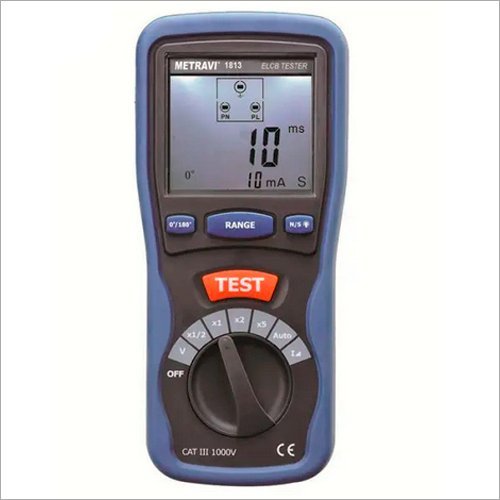How to Test ELCBs: A Step-by-Step Approach

Electrical safety is a cornerstone of modern living, with devices like Earth Leakage Circuit Breakers (ELCBs) playing a critical role in preventing electrical hazards. An ELCB is designed to detect earth leakages and disconnect the power supply to prevent shock, fires, or other dangerous situations.
Regularly using an ELCB tester is vital to ensure they are functioning correctly and providing the protection they are designed to deliver.
This article will walk you through the process of testing ELCBs step by step, ensuring both safety and effectiveness.
How ELCBs Work?
Before diving into the testing process, it is essential to understand what an ELCB does and its types. ELCBs come in two main categories:
- Voltage-operated ELCB (vELCB): These detect voltage on the earth wire and trip the circuit when a fault occurs.
- Current-operated ELCB (Residual Current Device, RCD): These monitor the current balance between live and neutral wires, tripping the circuit when an imbalance suggests leakage to the earth.
For practical purposes, the majority of modern systems use current-operated ELCBs, which are more sensitive and effective.
Why Test ELCBs?
Testing ELCBs is necessary to:
- Verify they are working correctly.
- Identify potential malfunctions caused by wear, environmental conditions, or electrical surges.
- Ensure compliance with safety standards.
Tools You’ll Need
To test an ELCB, you’ll need the following tools:
- ELCB Tester: A device designed specifically for this purpose, capable of simulating leakage currents.
- Multimeter: For measuring electrical values and verifying the circuit’s condition.
- Personal Protective Equipment (PPE): Gloves, insulated footwear, and safety goggles for your protection.
- Documentation: The circuit diagram or technical manual for the specific ELCB installation.
Preparing for the Test
- Power Off the Circuit: Always turn off the power supply to the circuit before handling any electrical components. Use a multimeter to verify that the circuit is de-energized.
- Inspect the ELCB: Check for visible signs of damage, such as cracks, burns, or loose connections. Ensure the wiring is secure and properly installed.
- Ensure Correct Environment: Perform the test in a dry and safe location. Remove any unnecessary electrical loads connected to the circuit.
Step-by-Step ELCB Testing
Step 1: Verify Manual Trip
Most ELCBs have a built-in test button. Press this button to simulate a fault condition.
- If the ELCB trips, it indicates the internal mechanism is functional.
- If it does not trip, the ELCB may be faulty or incorrectly installed, and further investigation is required.
Step 2: Measure the Trip Time
An ELCB tester allows you to measure the response time of the device under simulated fault conditions.
- Connect the ELCB tester to the circuit.
- Set the tester to inject a specific leakage current (e.g., 30 mA, depending on the ELCB’s rated sensitivity).
- Activate the tester to simulate a fault.
- Record the trip time displayed on the tester.
Typical trip times should be less than 300 milliseconds for a 30 mA leakage current. A delayed or inconsistent trip time could indicate a malfunction.
Step 3: Check the Trip Current
The trip current is the level of leakage current at which the ELCB activates.
- Gradually increase the simulated leakage current using the tester.
- Observe the point at which the ELCB trips.
- Compare the measured value to the ELCB’s rated sensitivity (e.g., 30 mA).
If the ELCB trips at a higher or lower value than specified, it may need replacement.
Step 4: Test for Nuisance Tripping
Nuisance tripping occurs when an ELCB activates unnecessarily, such as during normal appliance operation.
- Test the ELCB with small leakage currents below its rated sensitivity.
- Ensure the ELCB does not trip under these conditions.
If nuisance tripping occurs, it could indicate a problem with the ELCB or excessive leakage currents in the circuit.
Step 5: Perform Load Testing
After verifying the ELCB’s trip time and current, test it under normal load conditions.
- Reconnect all appliances and electrical loads.
- Simulate a leakage fault while the circuit is under load.
- Confirm that the ELCB trips as expected.
This step ensures the ELCB performs reliably in real-world scenarios.
Post-Test Considerations
- Record the Results: Maintain detailed records of the test results, including trip times, currents, and any observations.
- Address Issues: Replace or repair faulty ELCBs immediately to restore safety.
- Schedule Regular Testing: Establish a periodic testing schedule, typically once every six months, or as recommended by local regulations.
Safety Precautions
- Always wear appropriate PPE when working with electrical systems.
- Use insulated tools to prevent accidental contact with live parts.
- Ensure that only trained personnel perform ELCB testing.
Final Thoughts
Regular testing of ELCBs is essential to maintain electrical safety in residential, commercial, and industrial settings. By following this step-by-step guide, you can ensure your ELCBs are functioning correctly, protecting people and property from potential electrical hazards.
Investing time in proper testing not only enhances safety but also provides peace of mind knowing that your electrical system is in top condition.
What's Your Reaction?















